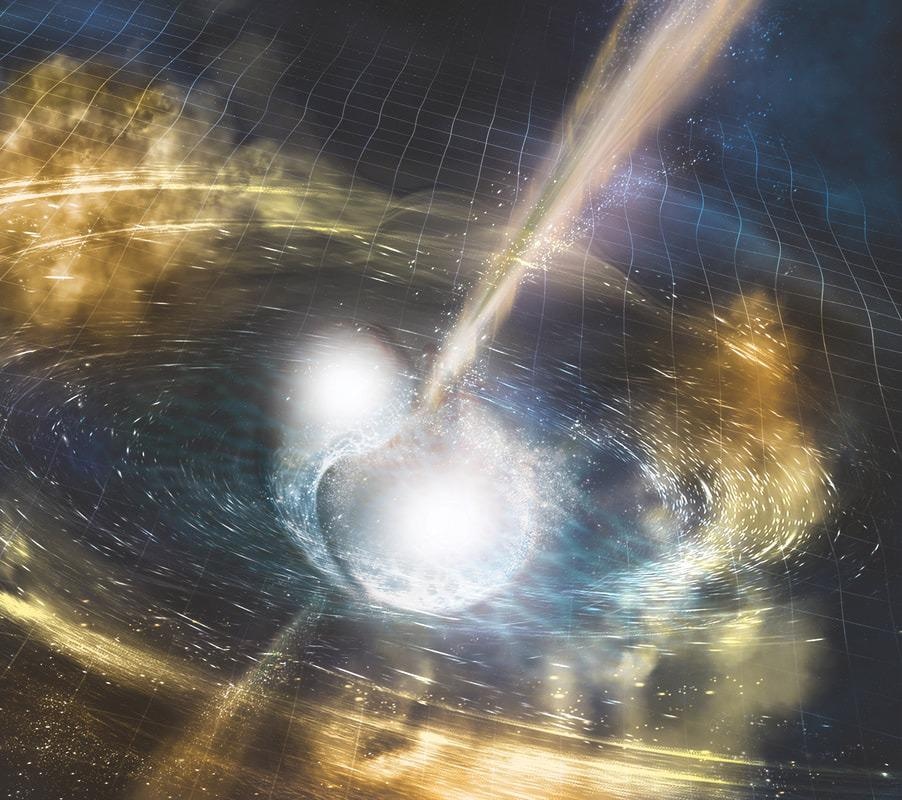Apr 27 2021
Researchers at the ARC Centre of Excellence for Gravitational Wave Discovery (OzGrav) have found a new technique to identify the birth population of double neutron stars.
 Artist’s illustration of a double neutron star merger. Image Credit: LIGO, Sonoma State University, A. Simonnet.
Artist’s illustration of a double neutron star merger. Image Credit: LIGO, Sonoma State University, A. Simonnet.
The recently published study investigated different stages of the life of double neutron stars, which are some of the densest objects found in the universe and form in collapsing massive stars.
Researchers can use gravitational waves—ripples in the fabric of space and time—to view the merging of double neutron star systems. The study of neutron star populations could help scientists know more about how they form and evolve. To date, only two double neutron star systems have been detected by gravitational-wave detectors but several of them have been viewed using radio astronomy.
One of the double neutron stars, named GW190425, viewed using gravitational wave signals is much more enormous compared to those found in typical Galactic populations observed using radio astronomy and exhibit a combined mass of 3.4 times that of the Sun.
This leads to the following question: why radio astronomy lacks such massive double neutron stars? OzGrav PhD student Shanika Galaudage, from Monash University, endeavored to find a solution by analyzing how to integrate radio and gravitational-wave observations.
The Birth, Mid-Life, and Deaths of Double Neutron Stars
Radio and gravitational-wave astronomy allow researchers to investigate double neutron stars at various stages of their evolution. Radio observations analyze the lives of double neutron stars. By contrast, gravitational waves analyze their final moments of life. For better insights into such systems, ranging from formation to the merger, researchers must study the link between radio and gravitational wave populations—their birth populations.
Shanika and her colleagues used radio and gravitational-wave observations to identify the birth mass distribution of double neutron stars.
Both populations evolve from the birth populations of these systems, so if we look back in time when considering the radio and gravitational-wave populations we see today, we should be able to extract the birth distribution.
Shanika Galaudage, OzGrav PhD Student, Monash University
The crucial way is to understand the delay-time distribution of double neutron stars: the time from the formation to the merger of such systems. The team postulated that more enormous double neutron star systems could be fast-merging systems, which means that they merge too fast to be observed through radio observations and could only be observed using gravitational-wave observations.
GW190425 and the Fast-Merging Channel
The research found slight support for a fast-merging channel, which suggests that heavy double neutron star systems may not require a fast-merging scenario to account for the lack of observations in radio populations.
We find that GW190425 is not an outlier when compared to the broader population of double neutron stars. So, these systems may be rare, but they‘re not necessarily indicative of a separate fast-merging population.
Christian Adamcewicz, Study Co-Author, Monash University
In forthcoming gravitational wave detections, scientists can expect the observation of more double neutron star mergers.
If future detections reveal a stronger discrepancy between the radio and gravitational-wave populations, our model provides a natural explanation for why such massive double neutron stars are not common in radio populations.
Dr Simon Stevenson, Study Co-Author and OzGrav Postdoctoral Researcher, Swinburne University of Technology
Journal Reference:
Galaudage, S., et al. (2020) Heavy Double Neutron Stars: Birth, Midlife, and Death. The Astrophysical Journal Letters. doi.org/10.3847/2041-8213/abe7f6.